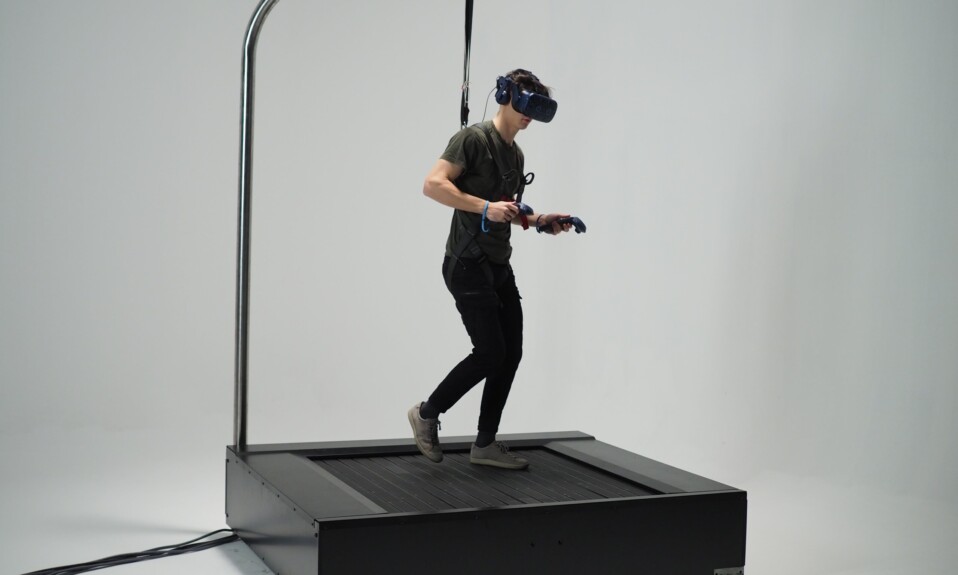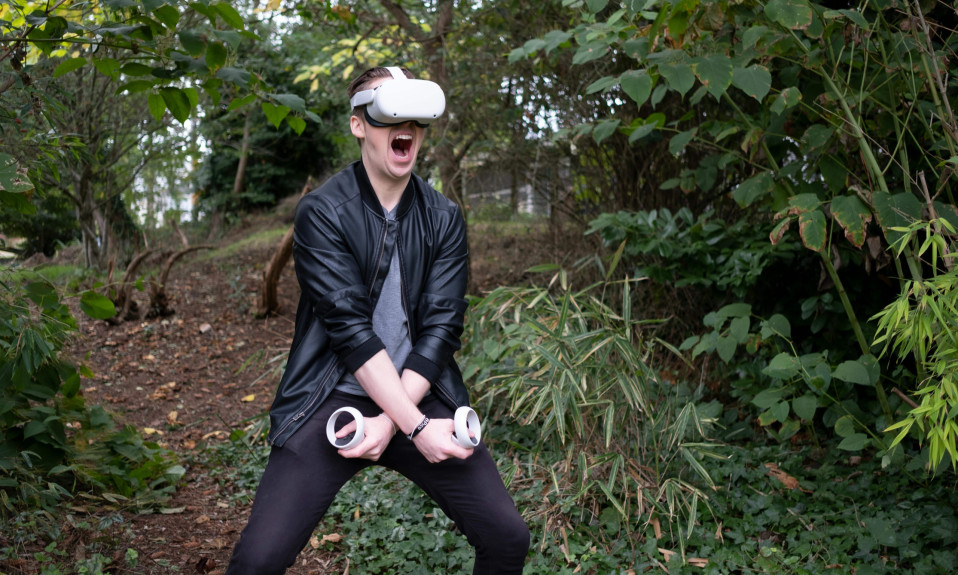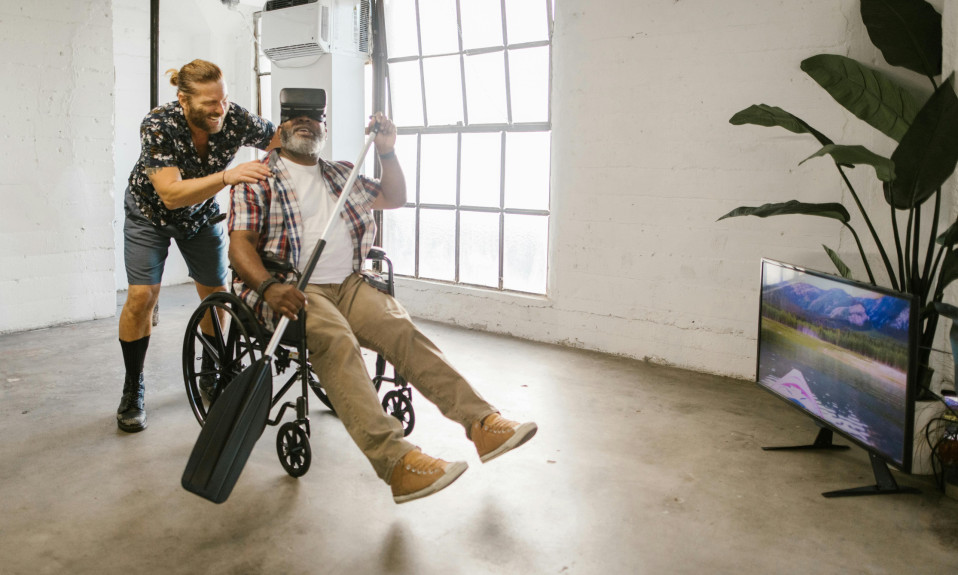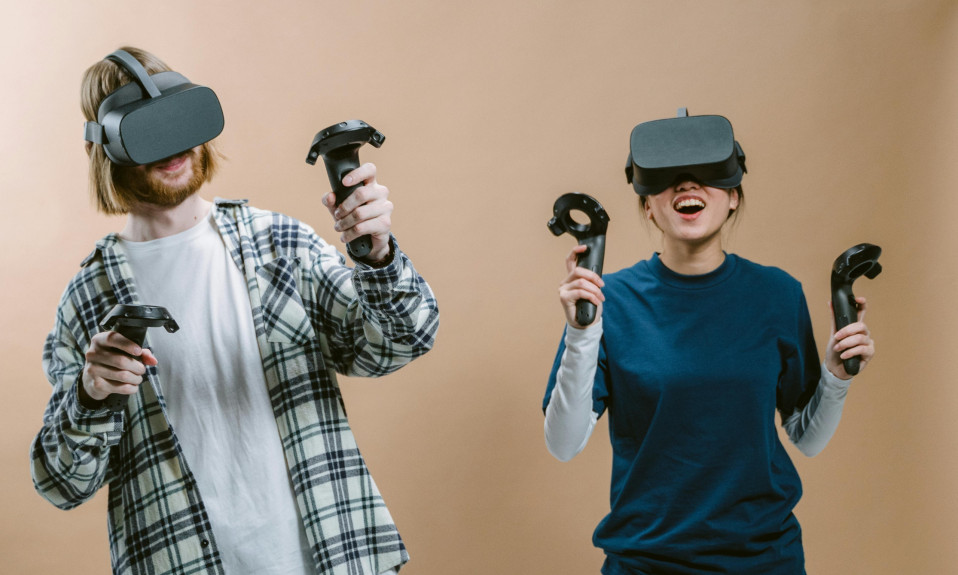Exploring digital environments and experiencing a deep connection that transcends physical proximity between participants in shared virtual spaces constitutes the driving force behind immersive virtual reality.
VR experiences, once limited to headsets and a pair of controllers, have evolved to include a broader range of accessories, such as VR treadmills, haptic suits, and full-body trackers—offering a greater sense of immersion and enhanced user interaction.
These devices aim to replicate the feeling of physical presence in digital environments, effectively blurring the lines between what is real and what isn’t.
However, videos of individuals bumping into walls and damaging appliances while strapped to VR headsets within their homes often circulate on the internet.
Such incidents highlight the challenges of navigating virtual environments in confined spaces where users risk physical injury.
We’d love to hear from you: Help shape the future of virtual reality, share your insights and make a difference.
Take the survey now!
Despite the potential of virtual reality treadmills to address these concerns by providing a more expansive and safe locomotion experience, these incidents signal a divide and lingering disconnect between locomotion in virtual reality and the real world.
It inadvertently begs the question: What does the future of locomotion in virtual reality hold?
Will users continue to bump into walls? Will they have to explore virtual reality within confined, obstruction-free spaces? Will they require supervision or perhaps limit physical activities when connected to VR?
This blog post delves into the various classes of omnidirectional and virtual reality treadmills, highlighting their quirks and simplifying the mechanisms behind their operations.
Without further ado, let’s get into it.
Quick Navigation
What is an Omnidirectional VR Treadmill?
An Omnidirectional VR treadmill is a device similar to treadmills that allow 360-degree movement by simulating physical motion in virtual reality using sensors and trackers
Omnidirectional treadmills are seen as an ideal solution to bridge the gap between locomotion in virtual reality and the physical world.
VR treadmill moves in all directions and ensures users stay within the boundaries of an enclosed locomotion interface.
We’d love to hear from you: Help shape the future of virtual reality, share your insights and make a difference.
Take the survey now!
Classification of Omnidirectional VR Treadmills
Omnidirectional VR treadmills can be classified into two broad categories based on user positioning systems and the locomotion interface of treadmills.
Each category of VR treadmill employs different mechanisms to ensure seamless experiences in VR and a lower risk of safety hazards for its users.
#1 Omnidirectional Treadmills Based on User Positioning Systems
Based on user positioning, omnidirectional VR treadmills get built with two approaches. The first approach uses a safety harness, and the other keeps users at the center of treadmills using sensors.
VR Treadmills Built with Safety Harness:
The ACTVR Cyber Mill One (CM1), set to launch in 2023, provides a strap-on safety harness that keeps users within the boundaries of the treadmill and prevents them from falling off.
“…a harness can provide body forces such as inertia or slope display, and may provide lifting force to simulate free-body flight”
With a safety harness, the surface area of VR treadmills can be scaled down to take up less space, but physical activities like rolling wouldn’t be possible.
The Kat Walk C series, Virtux Omni One omnidirectional VR treadmill simulators, and other iterations also employ safety harnesses.
VR Treadmills Built with CG Sensors:
This type of VR treadmill uses sensors to keep track of users’ center of gravity (CG) and pulls them towards its center as they move about the treadmill.
It eliminates the need for absolute dependence on a strap-on safety harness when using VR treadmills.
The Infinadeck VR treadmill is the pioneer of this locomotion interface, tracking six different points to precisely determine the position of its users.
When a user moves in any direction, the treadmill moves in the opposite direction. This mechanism tries to keep users within the boundaries of the treadmill.
For this process to run smoothly, VR treadmills are required to maintain the same velocity and acceleration as their user.
Destin from smarter everyday refers to this process as a “Semi-autonomous command position sensor.”
-Smartereveryday.com
If equilibrium between the user and the VR treadmill isn’t maintained, it may cause the system to overshoot and throw users off balance.
It is a crucial challenge with this model of VR treadmill that developers have to solve going forward.
Modular Omnidirectional Treadmill Floor (Disney’s HoloTile)
Designed by Disney’s Imagineers, Lanny Smoot, the HoloTile is an omnidirectional treadmill that combines a unique modular floor, lidar-based sensors, and advanced software technology to provide 360-degree movement for objects within digital environments.
Though still in the early stages of development, its structure presents the first hybrid VR treadmill classified into dual categories based on its unique user positioning system and locomotion interface.
The HoloTile’s locomotion interface includes a modular floor comprised of multiple individual tiles, each capable of operating independently and rotating in all directions around its axis.
Each tile selectively applies the principle of preferential friction to modulate the attractive forces between the tile surface and any object it comes into contact with.
The individual tiles can lock onto an object, move it in a desired direction, and reduce contact friction to facilitate motion when necessary.
Through active sensor monitoring, subtle tile movement, predictive motion algorithms, and natural gait simulation, the HoloTile ensures that users remain centered and stay within the boundaries of its modular surface at all times.
However, the HoloTile omnidirectional VR treadmill is still in its infancy, and mass-market production of consumer-grade versions may not be available.
We’d love to hear from you: Help shape the future of virtual reality, share your insights and make a difference.
Take the survey now!
#2 Omnidirectional Treadmills Based on Locomotion Interface
There are various models of VR treadmills with different working principles but similar objectives of omnidirectional movement for users.
While full or partial dependence on a safety harness can be a distinguishing feature, there’s more to the mechanisms of VR treadmills.
The locomotion interface of most omnidirectional VR treadmills has multiple pulley systems along the X and Y axis for 2-directional (2D) movement.
Other vital components include single or multiple conveyor belts and treadmills joined together like treads to move in a continuous loop in all directions.
Single Conveyor Belt Omnidirectional VR Treadmill:
The Infinadeck VR Treadmill uses a single conveyor belt system which eliminates the need to transfer motion and adjust tension associated with using a multiple belt system for locomotion.
It tilts in either the X or Y axis relative to the acceleration and direction of users.
Tilting creates inertia and prompts users to put in more effort when walking or running on the treadmill, improving the overall sense of immersion.
Omnidirectional Treadmill with Improved Running Capabilities:
Researchers from the Integrated institute of technology, Gwangju, proposed an omnidirectional treadmill to solve the problems of speed adaptation and scalability with existing ODTs.
According to the research team, geared omni-pulley (GOP) are the transmission mechanisms of this proposed omnidirectional VR treadmill model.
Omnidirectional treadmills built with this framework would support acceleration up to 3m/s2 due to its simplicity and lightweight structure.
It would allow users to easily change their direction of motion while compensating for such changes with speed adaptation and locomotion controllers.
We’d love to hear from you: Help shape the future of virtual reality, share your insights and make a difference.
Take the survey now!
Omnidirectional VR Treadmill Simulators:
Omnidirectional VR treadmill simulators are widely adopted devices used to simulate the 360-degree movement of omnidirectional VR treadmills.
Unlike ODTs, these devices use a low-friction stationary locomotion interface that receives information from foot trackers and maps users’ movement.
These low-friction surfaces also provide haptic feedback for users and allow a wide range of physical activities like running, crouching, or jumping effortlessly in any direction.
Omnidirectional VR treadmill simulators also employ safety harnesses to keep users confined to the treadmill.
These treadmills take up less physical space and can conveniently fit into confined spaces like a bedroom.
Virtux Omni One and the Kat Walk C series are great examples of omnidirectional VR treadmill simulators.
What Does the Future of Locomotion in Virtual Reality Hold?
Scenes from the movie “Ready Player One” give a glimpse of the future of locomotion in virtual reality.
Omnidirectional VR treadmills would play crucial roles in bridging the gap between locomotion in virtual reality and the physical world.
The technology and the mechanisms behind VR treadmills are a work in progress, and a lot needs to be done before going mainstream.
In the meantime, VR simulators serve as alternatives and can provide some sense of immersion for users in virtual reality.
No one knows what the future holds, but one thing is for sure, we’re a step closer to building an immersive virtual reality experience that would define the metaverse we all envision.
We’d love to hear from you: Help shape the future of virtual reality, share your insights and make a difference.
Take the survey now!






